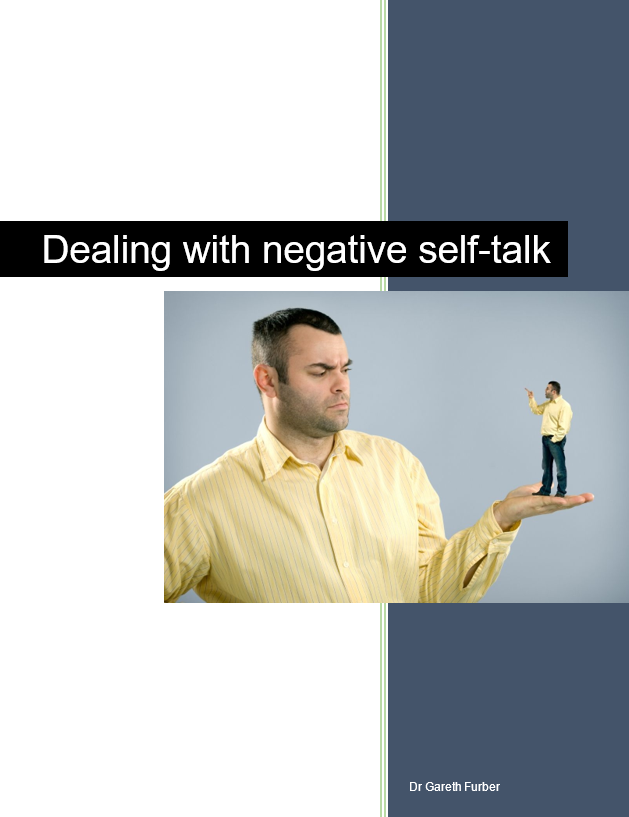
You know that brain of yours that does a whole lot of remarkable things (learning, sensing, problem-solving, loving, motivating etc)?
Well it ain’t perfect.
I don’t mean that as a diss.
I mean it is the case for all of us.
I liken the brain to a brilliant but slightly unhinged artist.
That artist produces some of the most amazing creative outputs in the world, but is also prone to rambling incoherently at times. The brain is the same.
Some of that random rambling comes in the form of negative self-talk – things the brain says about us that aren’t super friendly or nice.
“I’m stupid”
“I’m fat”
“I’m ugly”
Some amount of negative self-talk is normal and potentially helpful. For example, if my brain tells me ‘you’re being lazy’ when I should be studying for exams, it can have a motivational effect that gets me off my arse and into my books.
But negative self-talk can very quickly become demotivational. Spend too long listening to, or taking it too seriously and you can very quickly become upset.
In a previous post, I started talking about the cognitive-behavioural model and how you can use it in your everyday life. Central to the cognitive behavioural model is the idea that our thoughts influence our mood (emotions) and behaviour.
If your thoughts are dominated by negative self-talk, this can lead to low mood and withdrawal from usual activities.
Negative self-talk can also end up becoming a self-fulfilling prophecy. Keep listening to those thoughts that you are ‘lazy’ and you might find yourself withdrawing from the tasks you have to do (e.g. procrastination) which then leads to more self-admonishment. Keep listening to those thoughts that you are ‘ugly’ and you might stop taking care of yourself and your appearance. You can come to truly believe the thoughts.
There are a couple of cognitive behavioural therapy techniques that you can use to tackle excessive negative self-talk. Have a read of both and see what you think. A downloadable worksheet that guides you through these techniques is available at the end of this post.

Cognitive restructuring
Cognitive restructuring (or ‘thought challenging’) involves identifying those thoughts and beliefs that are causing us distress and challenging their veracity or their usefulness. The idea is to bring the thought/belief out into the open and examine it critically.
Fundamentally, this involves asking (and answering) a number of probing questions about the thought and its veracity. Your goal is to interrogate the thought/belief, in order to really test whether it is an accurate description of reality or whether it is really just the ramblings of a brilliant but flawed mind.
This includes questions like:
What is the evidence for this thought? What is the evidence against?
Am I basing this thought on facts, or on feelings?
Is this thought an oversimplification, when in fact the truth is more complex?
Am I misinterpreting or cherry-picking the evidence for this thought?
Would other people agree with this thought?
Could I be exaggerating?
Might I be making a common cognitive error?
Is this thought just a regular brain fart, or do the facts support it?
Has this thought been passed to me by someone? If so, are they a reliable or trustworthy person?
The goal of the process is to generate an alternative more balanced version of the thought/belief: one that has been generated through a robust examination of the validity of the original thought.
For example, in the process of interrogating the thought ‘I am lazy’, it might become clear that in fact you’ve been working very hard, but not scheduling appropriate rest periods. This leads to ‘crash’ days where you get nothing done because you are exhausted. The issue is not that you ‘are lazy’ but that you are not interjecting enough rest periods in your everyday schedule and hence are accumulating fatigue. In this case the alternative thought is “I am not giving myself enough rest time”. This alternative thought/belief is more accurate and also more helpful – it motivates appropriate corrective action.
So one component of cognitive restructuring is grilling a thought/belief until we can generate a more accurate and realistic replacement.
What about if the thought is true?
Sometimes, we are troubled by negative self-talk that does have some truth to it. Having interrogated the thought for a while, we realise it has some veracity. For example, we might be tormented by the thought ‘i’m fat’ and actually be significantly overweight.
In those situations, we need to subject the thought to some additional interrogation around its usefulness.
The ‘usefulness’ of a thought refers to the extent to which the thought provides us with an appropriate course of action to move forwards.
Does this thought motivate me to make positive changes in my life?
Does this thought tell me how to solve my problems?
Does this thought help me cope with what is happening to me?
Is this thought what I would tell someone who was struggling with a similar issue?
Is this thought the complete picture? or is it just a small part of the bigger picture?
It is very common to discover thoughts that are somewhat true, but totally unhelpful, demoralising, and void of any useful guidance on how to move forwards. They are also typically a gross oversimplification of the issue at hand.
Take the ‘i’m fat’ thought example. Even if it has a grain of truth to it:
- It tells you nothing about why you might be carrying some extra weight
- It tells you nothing about how you might go about addressing the issue
- It fails to consider that it might be health (not weight) that is the best indicator to be using to evaluate yourself
- It pretends like weight is the most important factor in life, when it clearly is not
- It implies that ‘fat’ is bad, when in fact many different body shapes can be healthy and attractive
- It reduces who ‘you’ are down to your weight/fat content, when humans are far more than their physical appearance
- All it does is make you feel unhappy and unmotivated
As far as a thought goes, it is kinda useless.
From this point, you can start generating an alternative thought to replace it; one that captures the complexity and richness of the situation and one that leaves you feeling motivated and driven to make positive changes in your life (which may have nothing to do with weight). In this case it might be “I am carrying some extra weight, but I am healthy and living my life fully. I am not going to be defined by my weight”.
So, to summarise, cognitive restructuring (thought challenging) involves subjecting troublesome thoughts to significant scrutiny, and replacing them with thoughts that are more accurate and/or more useful.

Cognitive defusion
Whilst cognitive restructuring involves critically examining a thought, cognitive defusion involves learning how to get less entangled in thoughts. It is about:
- accepting that negative self-critical thoughts do show up
- learning to create some psychological distance from those thoughts
- learning to recognise thoughts as simply thoughts, nothing more or less
- learning to notice thoughts and let them go, rather than getting caught up in them
Rather than engaging in a detailed examination of a troublesome thought, cognitive defusion invites you to establish a new relationship with that thought.
Cognitive defusion is the antidote to sticky thoughts, thoughts that we ‘fuse’ with. Sticky thoughts are ones that we can’t let go of, that stick around, that we hold to be completely true.
If you aren’t convinced that some thoughts are sticky, whilst others aren’t, try this exercise.
Think to yourself “I am a banana”. My guess is you won’t get stuck to this thought. Namely, you won’t actually believe you are a banana or be troubled by the idea that you are banana. Now how about the thought “I’m a bad person”. That one might be a little stickier. It might bring to mind things you’ve done you aren’t proud of. It might be harder to shake. You might find that thought a little more troubling. You’re more likely to fuse with it.
Fusing with a thought means becoming entangled with it. Entanglement might include ruminating on that thought, obsessively collecting evidence for that thought, trying hard to suppress the thought or feeling like the thought defines you.
When ‘defusing’ from a thought, the goal isn’t to examine the validity of the thought (as we might with cognitive restructuring) but rather to examine what impact that thought has on how you’re living your life. If that thought is stopping you from expending your energies on building the life you want, then your relationship with that thought is unhelpful and and a new relationship should be formed.
How does one change one’s relationship with a thought?
This is done using a number of techniques that can help you find some distance from difficult thoughts, and weaken their perceived grip on your mood and behaviour. Through regular practice of these techniques, you can come to notice thoughts as simply events in your head, and not necessarily accurate or meaningful appraisals of reality.
You’ll find a bunch of these techniques on the attached worksheet. They include things like:
– Giving thoughts a physical form (e.g. giving them a shape, colour, size, temperature) and then imagining doing something with those physical objects (bouncing them, throwing them, melting them, exploding them)
– Saying difficult thoughts in a silly voice as though they were generated from a cartoon character
– using the phrase “I’m having the thought that……..” before verbalising a thought, to ensure it is named for what it is
So, in cognitive defusion, the goal is not to challenge the veracity of the thought, but to weaken its grip on the choices you make and the way you live your life. Cognitive defusion relegates thoughts to a less prominent role in your thinking; accepted, but not battled. Relieved of their power to control you.
Which method should I choose?
Each method has its strengths and weaknesses. Cognitive defusion can be quite powerful when you are right in the middle of a battle with negative self-talk. Imagine, in a moment of significant distress because of negative self-talk (thoughts like “i’m crap”, “i’m terrible”, and “i’m useless”) suddenly deciding to sing all those thoughts to the tune of Game of Thrones. Defusion can break you out of a introspective ruminating emotional rut.
Cognitive restructuring, on the other hand, is a good medium to long-term strategy for taking those thoughts/beliefs and really interrogating their veracity and value in your life. It takes hard work and persistence to interrogate and modify a thought, especially if you’ve been having that thought for a long time, and have made it a part of your self-concept. But the capacity to question your thoughts and beliefs is a powerful critical thinking tool that you can use in many situations.
So my answer to the question of which method should you choose, is to choose both. Negative self-talk, when it is controlling your life, deserves to be taken on at all fronts. You will determine over time, the strategies that work best for you.
If you find this stuff helpful, you might benefit from doing one of the many online CBT courses that go into these kinds of techniques in more detail.


